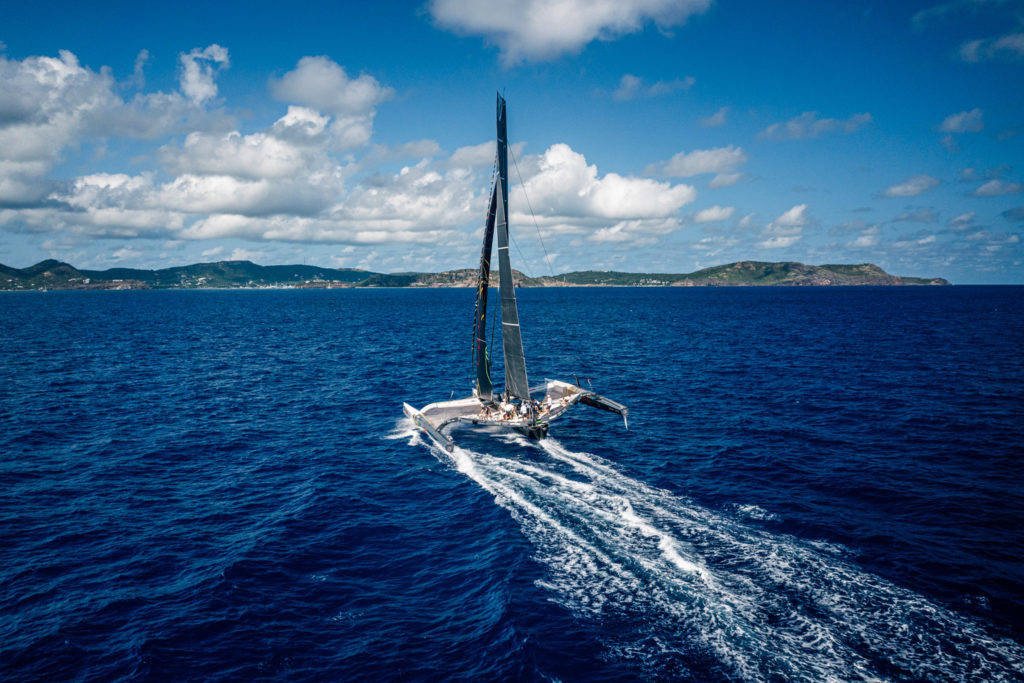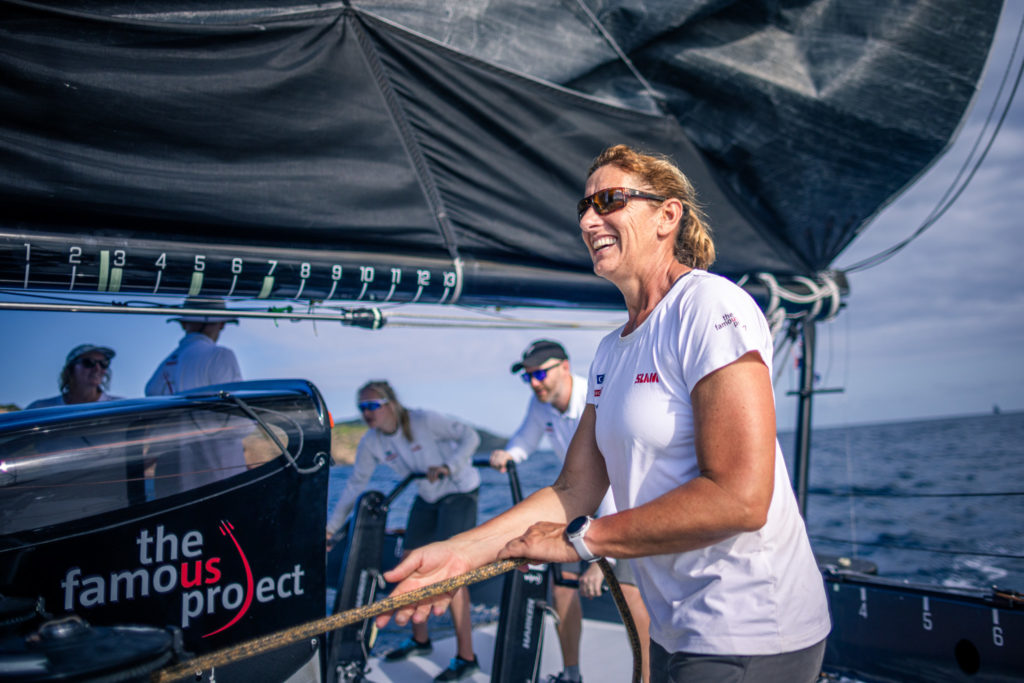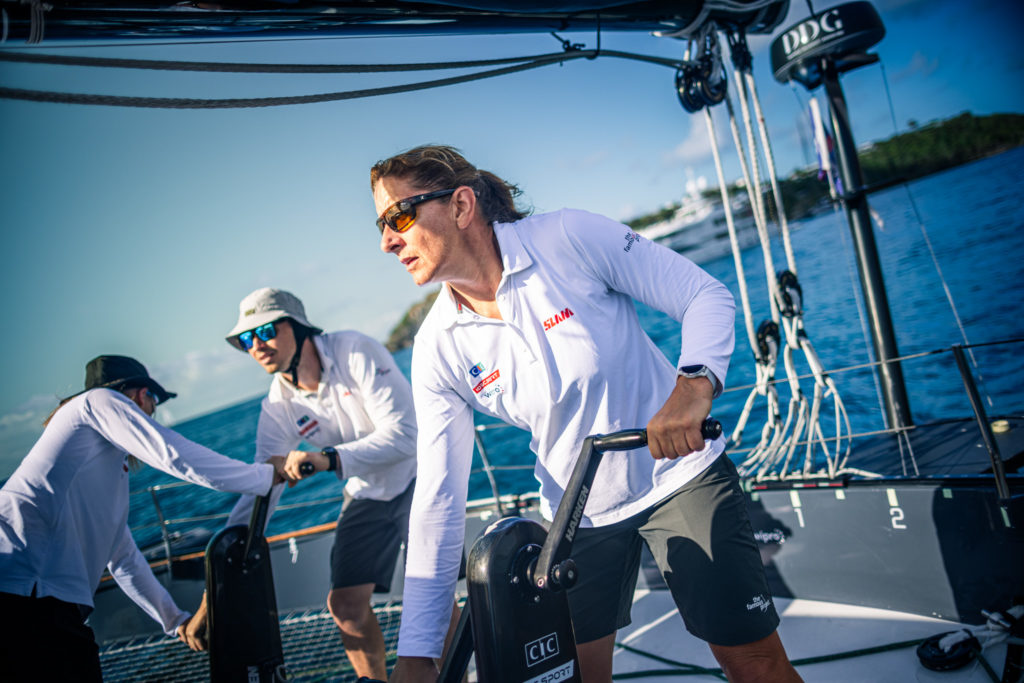
It was great to return to Antigua mid-February to train and prepare for the RORC Caribbean 600 race. The Famous Project had the core crew of Alexia, me, Marie and Elodie as well as Debs Blair, who had been invited to join the team. Tom Dawson returned as our on the water coach, with Miles Seddon and Jack Boutell.
We had learnt from the Transatlantic Race and identified areas where improvement was needed. As a more intense race, the Caribbean 600 Race would require us to do multiple sail changes and sail on every point of sail against the formidable teams of Argo and Zoulou. We would be up against two MOD70’s with the next generation of foil package to gain extra speed and lift and experienced teams onboard.
We used the great Antigua 360 Race as training and blew away some cobwebs on the 50 nm course around Antigua. We could feel the improvements each day and were excited to take on the RORC Caribbean 600 race.
The forecast for the race was for steady mid-range winds, nothing scary on the course and we knew we would finish before the light winds slowed most of the competitors, delaying their finish times. We lined up with 10 of the 64 competitors for the last start in the sequence and had a strategy that we executed well – steer clear of other boats, create space to cross the start line at speed and on time. We then took the first tack against the shoreline of rocks which also went according to plan. We sailed through the fleet looking for the first corner of Green Island to set up for the leg towards the North Sails mark at Barbuda. Holding our lane and delaying our sail change to the Genniker, we managed to reach the next mark ahead of Zoulou, rounding in second place behind Argo. It felt like the race was on and it was going to be intense for the full 600 miles.

Rather frustratingly I took over the helm just as we approached a transition zone resulting in us losing valuable miles to Zoulou. My takeout from this experience is that I really need to work on sailing in different modes. We passed by Nevis, St Kitts and Saba with different acceleration zones between the islands which required multiple sail changes. Then we were back upwind towards St Barts and rounding the island just as it was getting dark. We trusted the navigation calls to round the obstructions and change to the Genniker and went on to round St Maarten in darkness before heading upwind along the Anguilla Channel, back towards St Barts and the long leg down to Guadaloupe. This leg was long enough for us to all get a couple of hours sleep in a bunk which was most welcome.
We approached Guadaloupe at dawn which allowed us to see the light winds, puffs and dead zones as we rounded the southern end of the island. We had Argo and Zoulou within our sights, just 11 miles ahead, and didn’t slow as much as them but not enough to make a difference as we entered a typical Caribbean rain squall when we rounded La Desirade Island.
The competition were the other side of a cloud that dealt us a huge header and increase of wind, with stinging rain obscuring our vision. As we exited the other side, we experienced the light zone with a horrible sea state and it took us a while to make good headway again.
Back to playing catch up, we fought our way back to Barbuda before bearing away at the North Sails mark and enjoying one of the best legs of the course. With a true wind angle of around 110, we accelerated towards the small island of Redonda at speeds of 30 knots. These awesome conditions were accompanied by a huge grin on my face as I drove straight and fast, trusting Elo and Marie to trim and keep us in control. The small wind shadow around Redonda didn’t stop us as we then took on the final upwind leg towards the finish.
Delighted with a podium finish after 600 miles, we were just 2 hours behind Zoulou, who themselves had challenged Argo throughout the race. It was a huge leap forward in our ability to handle this impressive beast around the course, executing sail changes, being proactive and driving fast. This race was an excellent training exercise. There was always something happening and to plan for, it was short but intense, it allowed us to grow in confidence of the boat and each other but above all else – it was so much fun.

With the race over, we transitioned Limosa from racing to delivery mode as our next objective was to sail back across the Atlantic and return to France. It is still early in the season to find decent weather to do this and many of the routing options involved a lot of motoring and being in survival mode. With a new crew set up to sail Limosa home we wanted to use this as a training exercise, so we waited for a window of opportunity that would deliver the right conditions. Being on standby itself was great training although I will concede that it was probably easier in Antigua than it will be in Brest where we will be waiting for our departure on the Jules Verne Trophy attempt next November.
However, this delivery was not to be and we reluctantly made the decision to fly home and return when we have better weather options. So, I am now UK based for March with another big voyage coming up in April.